
The Best of Everything
Encyclopedia Entry • Films Main
Hollywood Canteen
1944

Critics' Reviews • Our Reviews • Movie Posters • Lobby Cards • Misc. Images
Click here to see photos from the film.
US general release: 12/31/44.
VHS release: 7/24/91. DVD release: 11/11/2008.
Cast: Joan Leslie, Robert Hutton, Dane Clark, Janis Paige. Guest stars include: the Andrews Sisters, Jack Benny, Joe E. Brown, Eddie Cantor, Kitty Carlisle, Jack Carson, Joan Crawford, Bette Davis, John Garfield, Sydney Greenstreet, Paul Henreid, Peter Lorre, Ida Lupino, Irene Manning, Joan McCracken, Dennis Morgan, Eleanor Parker, Roy Rogers and Trigger, Barbara Stanwyck, Jane Wyman.
Credits: Original Screenplay: Delmer Daves. Producer: Alex Gottlieb. Director: Delmer Daves. Camera: Bert Glennon. Art Director: Leo Kuter. Musical Director: Leo F. Forbstein. Musical Numbers: LeRoy Prinz. Music Adaptation: Ray Heindorf. Editor: Christian Nyby.
Plot Summary: The West Coast's answer to Broadway's Stage Door Canteen, the Hollywood Canteen was created as a GI morale-booster by film stars Bette Davis and John Garfield. The Canteen was established so that Our Boys on leave in Tinseltown could have a good time with good food and good dancing -- and, as a bonus, rub shoulders with their favorite movie personalities, who functioned as waiters, chefs, busboys and dancing partners. Since the 1944 all-star flick Hollywood Canteen was produced by Warner Bros., it was only to be expected that the celebrities seen herein would consist mostly of Warner Bros. contract players. The frail plot concerns a soldier on medical leave (played by Robert Hutton) who falls in love with lovely leading lady Joan Leslie (played by Joan Leslie) while visiting the Canteen. Bette Davis and John Garfield are on hand to emcee the Canteen's variety acts, and to act as cupids for the Hutton/Leslie romance. The "supporting cast" includes the likes of The Andrews Sisters, Jack Benny, Joe E. Brown, Eddie Cantor, Sidney Greenstreet, Paul Henreid, Peter Lorre, Ida Lupino, Dennis Morgan, Roy Rogers, S.Z. Sakall, Barbara Stanwyck, and the Jimmy Dorsey and Carmen Cavallaro musical aggregations. Virtually everyone involved donated their salaries to the Canteen fund--even Jack Benny. As with most of these patriotic wartime star rallies, the results are a mixed bag: the best sequences include Benny's violin "duel" with Joseph Szigeti and Roy Rogers and the Sons of the Pioneers introducing Cole Porter's "Don't Fence Me In." Hollywood Canteen won three Oscar nominations, more for its good intentions than its inherent excellence. Still, don't pass up the opportunity when this "movie star salad" shows up on cable TV. ~ Hal Erickson, All Movie Guide
Awards: 1945 Oscar nominations: Best Music, Original Song: "Sweet Dreams, Sweetheart" (music, M.K. Jerome; lyrics, Ted Koehler). Best Music, Scoring of a Musical Picture: Ray Heindorf. Best Sound, Recording: Nathan Levinson.
|
Bosley Crowther in the New York Times December 16, 1944
If it's quantity you want in entertainment — entertainment, that is, of the sort that is generally thrown together in an "all-star benefit show"—then the Warners' grotesquely laden "Hollywood Canteen" is for you. As a matter of fact, you'll probably love it if you're frankly susceptible to "names." For this two-hour-and-four-minute catch-all, which came to the Strand yesterday, gives out with short snatches of diversion (and some not so short) by virtually every player on the Warner lot. It has every sort of thing, from Eddie Cantor and Nora Martin singing the so-called "Baby Song" to Joseph Szigeti and Jack Benny doing a violin travesty of "Souvenir." It also has Roy Rogers, borrowed from Republic, singing "Don't Fence Me In," and the Andrews Sisters, borrowed from Universal, singing "Gettin' Corns for My Country," a fitting song. But if it's quality you want in your entertainment and just a slight touch of dramatic grace, beware the elaborate hocus-pocus of "Hollywood Canteen." There is not a fairly distinguished song or turn of dialogue in the show, and the story which binds the "acts" together is an embarrassingly affected affair. It is the story of a South Pacific veteran who goes to the Hollywood Canteen, that famous caravansari for service men, and meets his dream girl, Joan Leslie. It's a recount of his speechless admiration every time he sees a famous movie star and of his almost unbearable exuberance when Miss Leslie actually bends to his romance. To be perfectly blunt about it, this film seems a most distasteful show of Hollywood's sense of its importance and what its people are doing for "the boys." Throughout it plainly points benignly to the wonder of "big shots" entertaining little ones and it stretches propriety to the limit in demonstrating how human the stars are. There is no question that the Hollywood Canteen has been a most welcome haven to service men and that it has done a lot to help them. But this advertisement seems a most ungracious boast. Comparison of this film with "Stage Door Canteen," a previous star show, is inevitable, since both of them follow the same pattern—and were, in fact, both written by the same man. It is notable that the former was much more modest in its account of show folk devoting themselves to service men and much more realistic in its development of a romance. It is also much more distinguished in the quality of the entertainment put out. In the present film, Miss Leslie plays herself with elaborate sweetness and Robert Hutton plays her soldier-courtier in the manner of a musical comedy juvenile. Dane Clark is broad and obvious as an ungrammatical sergeant from — yes, Brooklyn—and thirty or forty other people play themselves (see cast above). In a more or less introductory comment, Joe E. Brown describes Hollywood Canteen: "This place is just a great big juke box." So is the film. It is that full of stuff.
Kate Cameron in the New York Daily News (1944): It is an elaborate show, but it is presented by author-director Delmer Daves in such a patronizing manner as to make one blush for its complete lack of reserve in singing the praises of Hollywood. It boasts screen personages unashamedly and without a flicker of humor. The players in the picture seem constantly awed by their own gracious and hospitable entertainment of the servicemen.
Variety (1944): There isn't a marquee big enough to hold all the names in this one, so how can it miss? Besides, it's basically solid. it has story, cohesion, and heart. That's not a bad parlay, either.
Doug Pratt on dvdlaser.com: One of the best of the 'Canteen' movies, the film's surreal parade of stars, portraying touchy-feely versions of themselves, never ceases to be fascinating, and the movie's pace, musical numbers, and contrived dramatic framing device are breezier than most. Our favorite moment is a well-written interlude featuring Sydney Greenstreet and Peter Lorre ("He didn't trust us, Peter." "Oh, and we are such gentle people." Greenstreet raises his eyebrows, "Are we?"), but others will find giddier pleasures in the specter of Joan Crawford, Bette Davis and John Garfield happily, and indeed enthusiastically, rubbing elbows with the ordinary, hardworking, uniformed common folk.
threemoviebuffs.com (2010): ...What passes as a plot is really just an excuse to get inside the club for a series of movie star cameos. Robert Hutton and Dane Clark play two GI’s on medical leave from the South Pacific. Hutton plays Slim a shy guy with a huge crush on Joan Leslie. Clark is Sergeant Nowland a loudmouth from Brooklyn and Slim’s best pal.
The story is any soldier or sailor’s shore leave fantasy come to life. Slim gets to experience Hollywood by rubbing shoulders with many famous Warners' stars (they originally approached Paramount, MGM and other studios about contributing stars for cameos but were turned down). He is crowned the one millionth service member to enter the Canteen and wins a date with Joan Leslie, a hotel suite for the night and the use of a fancy car.
The list of stars is quite impressive; see cast list above. The best ones are Ida Lupino and Joan Crawford who both have amusing scenes with Clark. Sydney Greenstreet and Peter Lorre have a funny moment where they scare an overly exuberant soldier who has been dancing with Patty Andrews and Jack Benny does one of his silly violin routines. Full review.
|
If you've seen Hollywood Canteen and would like to share your review here, please e-mail me. Include a photo or avatar of yourself, a star-rating (with 5 stars the best), as well as your favorite lines from the film.
Rating:
In late June 1943, Joan left MGM after 18 years. Two days later, she was put on the Warners payroll with a 6-year contract for a 3-picture, $500,000 deal. (Joan would stay under contract at Warners until 1952.)
Hollywood Canteen, a WW II "Support the troops!" propaganda picture, was the first film Joan made for her new studio, although she only appears for less than 2 minutes, along with dozens of other top Warners stars. The film is based on the goings-on at the real-life Hollywood Canteen, founded by Bette Davis and John Garfield and located at 1451 Cahuenga Blvd in Hollywood from 1942 through 1945.
To get right to the Joan-gist: Joan's brief cameo occurs about an hour into the film; she's wearing a blouse with a hideous cartoon cat sprawled across both the front and back. After overhearing soldier Dane Clark say that he's "off women for the duration," Joan says: "Isn't that an unfortunate attitude to have at the Hollywood Canteen?" After she asks him to dance, he first offers to name the cat on her shirt, then: "Has anyone ever told you you look like Joan Crawford?" She replies: "Well, yes, my husband has." Clark doesn't really think she's Joan, but when she reveals she actually is, he literally faints. Thus is Joan's uber-bland beginning of her new Warners career---which thankfully would soon get more exciting with the next year's Mildred Pierce!
The whole film is primarily a series of cameos by Warners stars (e.g., wisecracks by Joe E. Brown and Eddie Cantor; funny menacing by Sydney Greenstreet and Peter Lorre; soldiers flirting with the likes of Barbara Stanwyck, Jane Wyman, Ida Lupino) interspersed with a variety of musical numbers that include the following:
JImmy Dorsey and his Orchestra Jack Carson and Jane Wyman: "What
Are You Doin' the Rest of Your Life" Eddie Cantor and Nora Martin: "We're Having a Baby" Sons of the Pioneers ("Tumbling Tumbleweeds"---after which the Middle American main character Slim Green [played by Robert Hutton] says "I really go for that Cowboy music." Responds Brooklynite Dane Clark: "Yeah, it reminds me of Flatbush.") Roy Rogers and Trigger: "Don't Fence Me In." (With Trigger doing tricks before and after.) Andrews Sisters: "Corns for My
Country" and "Don't Fence Me In." A "violin battle" of "Souvenir" between classical violinist Joseph Szigeti and Jack Benny. Pianist Carmen
Cavallero: "Voodoo
Man"
Actual Canteen founders Davis and Garfield pop up time and time again to sign autographs, do dishes, announce winners of contests, etc. Bette closes out the movie as a ghostly presence superimposed on the screen over a shot of the Canteen, intoning to all Allied soldiers (including "our own colored boys," Russians, Philippinos, et al): "Wherever you go, our hearts go with you..."
The musical numbers are mildly entertaining enough, with a wide selection of styles (from schmaltz to modern swing to country to classical) designed to appeal to all segments of the population. But I did get mightily annoyed with a few things:
(1) The plot forced upon the proceedings: Stereotypical Middle-American Boy (played by Robert Hutton as "Corporal Green") and his stereotypical wisecracking Brooklyn buddy (Dane Clark) get a 3-day leave in Hollywood, where Hutton sincerely expresses to one and all his puppyish devotion to Warners starlet Joan Leslie. Lo and behold! Here she is at the Canteen! And she sings to him! And they fall in love! And she takes him home to meet, and pray with, her parents! At the end, she sees Corporal Green off at the train station after his leave is up, implying that, though she's an up-and-comer in Hollywood, she will, nonetheless, wait for him to come back from the war. I found all of this pretty unrealistic and condescending to the viewing public, as in: "See! You, too, Average Joe, can really have a Hollywood star fall in love with you!" Dane Clark's wise-guy does provide some needed relief from the saccharine love of Hutton and Leslie, with his kvetching and ongoing pursuit of a starlet-wannabe who claims "I live for my art!" (while actually working as a studio messenger girl).
(2) The patronizing attitude of the Warners stars: All of the Big Warners Stars at the Canteen are a bit too self-congratulatory about being so utterly patriotic and "democratic." Aside from the numerous patriotic speeches, this overwrought aspect of the film is stated outright when Dane Clark's lowly Brooklyn man is oh-so-grateful for "all the famous people being friendly and democratic." Most of the Warners stars that appear, both male and female, are overtly portrayed as "good eggs" who aren't too big to wait tables or do the dishes but are, nonetheless, pretty condescending, as if seemingly thinking to themselves: "Oh, look how kind we are to the Little People who can't properly dance or speak French!" Even Joan looks askance at poor Dane!
(3) Why the Joan McCracken dance number? This bit occurs when Hutton and Clark are given a tour of the Warners lot. Hutton sees a love scene with Joan Leslie and Zachary Scott (after which Scott unpleasantly wipes his mouth) and gets jealous (OK, that's still kind of relevant to the boring plot), while Clark's Messenger Girl takes him to McCracken performing a lengthy pouting and bow-legged dance--- "Ballet in Jive." McCracken (of recent Oklahoma! fame and wife of Jack Dunphy, Capote's later long-time lover) was, of course, a recent acquisition of Warners, which they felt the need to show off here. There's absolutely no reason for this sequence being in the film.
Hollywood Canteen's director Delmer Daves also wrote the weak screenplay for the film (in addition to writing the previous year's Stage Door Canteen, the similar Broadway-star version of entertaining the troops). Despite its blatant shortcomings, Hollywood Canteen was Warners' top-grossing film (and the nation's 5th-grossing) for 1944.
|
gre
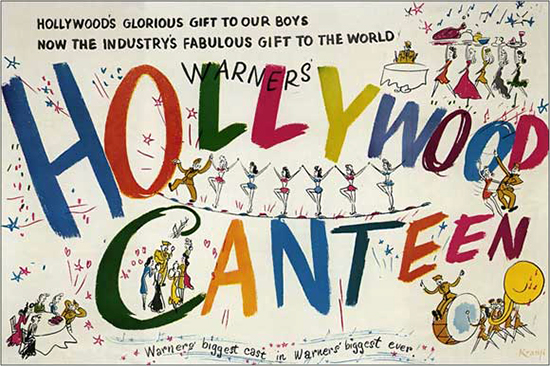
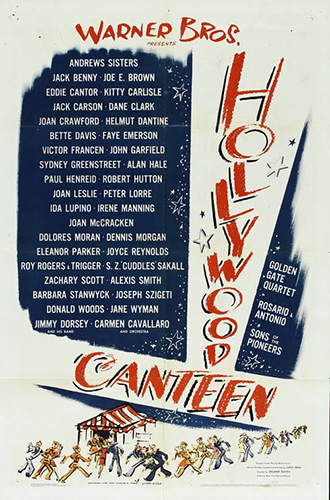

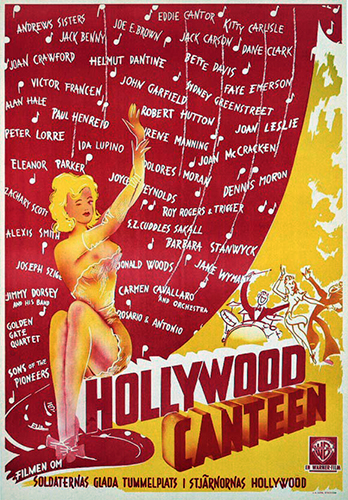



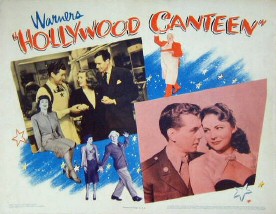
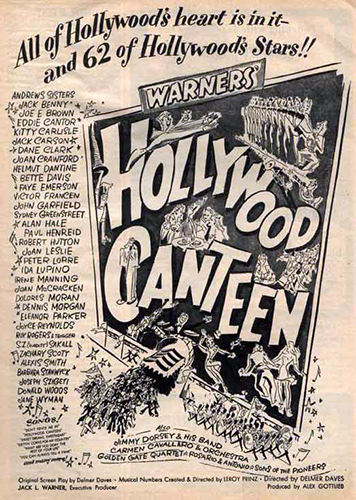
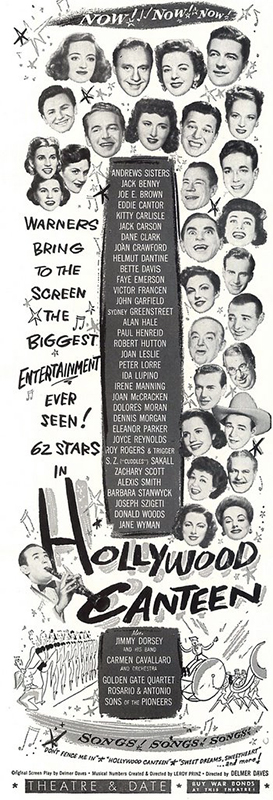




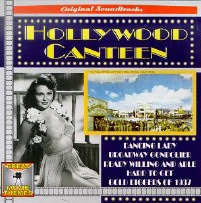
See the Recordings page for complete track listings and description.
The Best of Everything